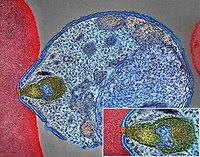
Photo from wikipedia
While the development of land for residential housing along the Swan and Canning Rivers in Perth, WA, Australia has reduced natural mosquito breeding sites, the role of backyard container breeding… Click to show full abstract
While the development of land for residential housing along the Swan and Canning Rivers in Perth, WA, Australia has reduced natural mosquito breeding sites, the role of backyard container breeding remains a relatively unknown factor. Local Governments responsible for these areas focus management and control efforts on low lying, tidally driven mosquito habitats to control Aedes vigilax (Skuse) and Aedes camptorhynchus (Thomson) mosquitoes in an effort to reduce both the nuisance and disease risk to residents. In spite of their efforts, Local Governments continue to receive complaints regarding mosquito nuisance, even when environmental conditions do not favor hatching and development of the two species in the Swan River tidal flats. In this study, 150 backyard inspections were conducted in the residential suburb of Bassendean, Perth, WA, Australia, situated in close proximity to the Swan River tidal plain. The occurrence and species composition of the mosquito fauna found in residential backyards was documented. Of the backyards inspected, 94% were found to possess containers capable of breeding mosquitoes, although only 3% contained mosquito larvae. Nine species of mosquito were collected from containers ranging in capacity from 0.05 to 50 L across the study area. Additionally, encephalitis virus surveillance trapping was conducted within residential properties and compared to the tidally driven natural habitat at Ashfield Flats and a tidally influenced brackish creekline at Bindaring Park. The species composition of the fauna at the three habitat types differed significantly, with Aedes notoscriptus (Skuse) dominating residential lots and A. vigilax more prevalent at the saltmarsh site. Bindaring Park had an adult composition at the mid-point of these two habitats, reflecting its proximity to both the Swan River and residential lots.
Journal Title: Frontiers in Public Health
Year Published: 2017
Link to full text (if available)
Share on Social Media: Sign Up to like & get
recommendations!